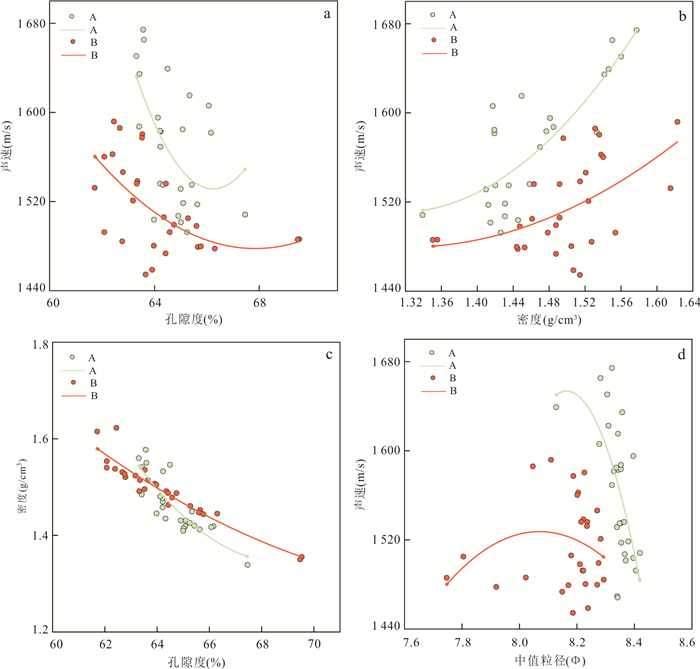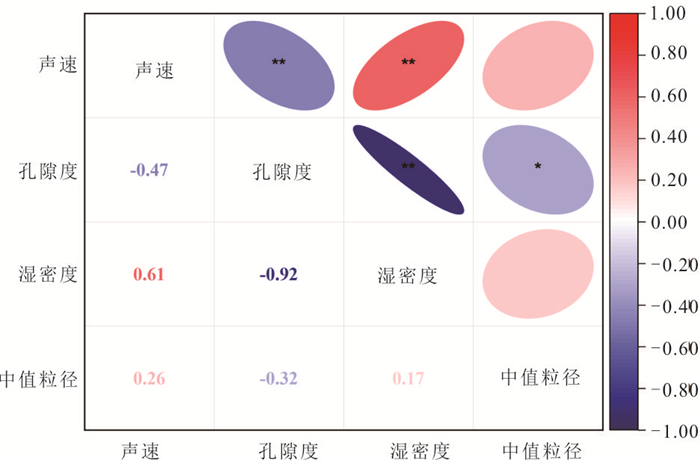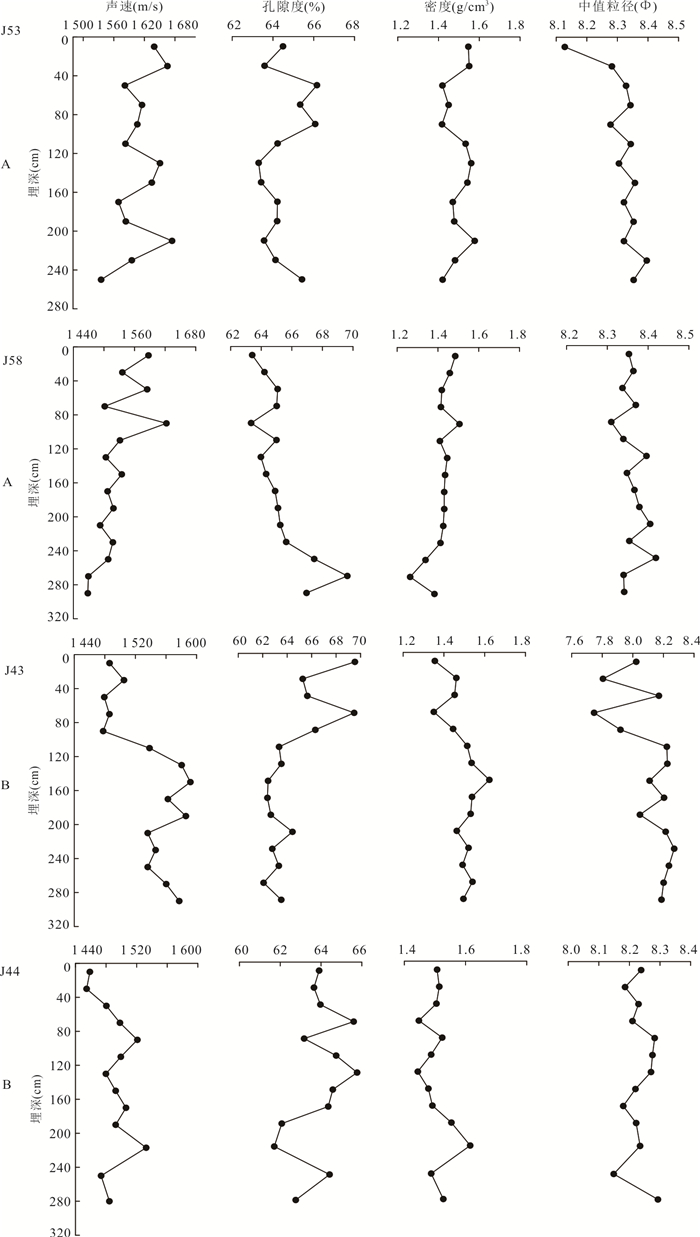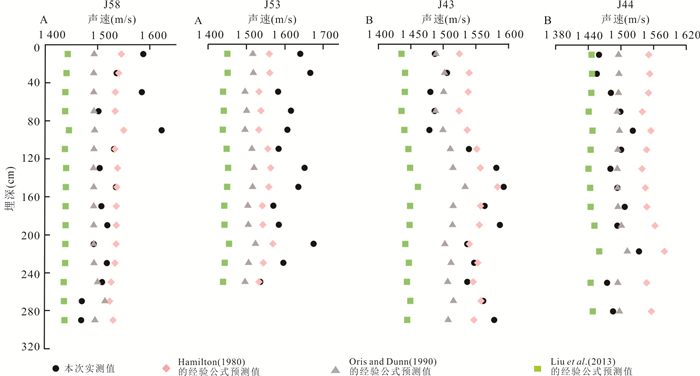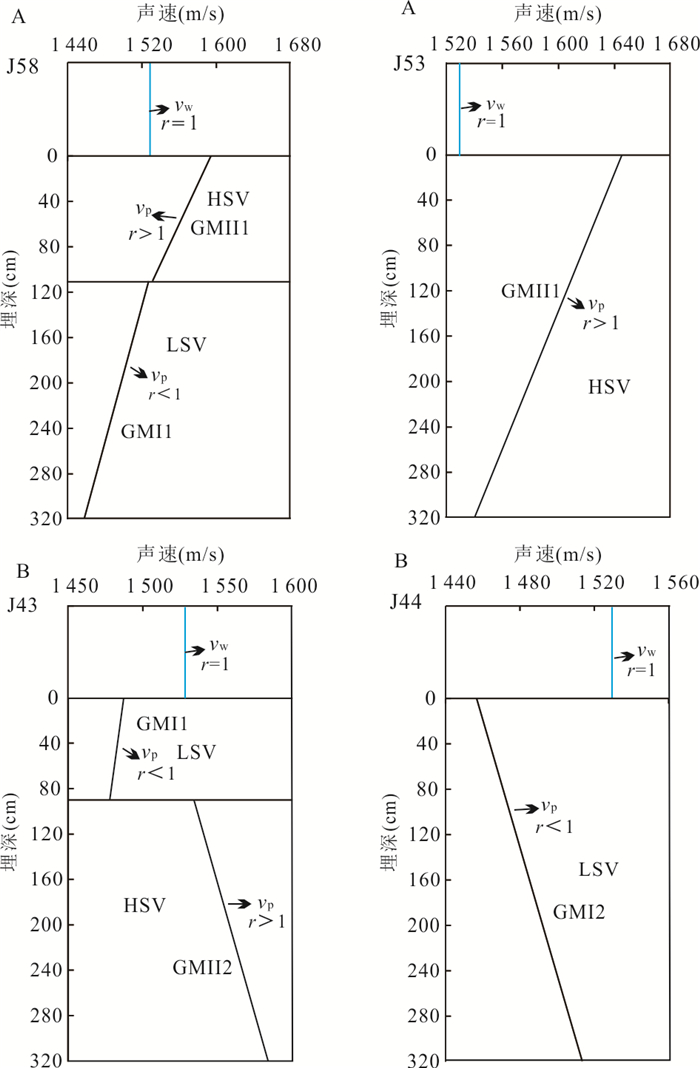Characteristics of Sound Velocity Structure in Deep Water Sediments of West Philippine Sea
-
摘要: 深海沉积物的声速是构建海洋环境声场的基础.对西菲律宾海4 818~6 630 m深水海域获取的海底沉积物柱状样的纵波波速、湿密度、孔隙度以及中值粒径等参数进行了测试与分析,阐明了研究海域海底沉积物声学与物理参数基本特征及垂向变化特征,探讨了物理参数对声速的影响,并对实测数据及经验方程预测值进行对比,提出了研究区海底沉积物四种典型声速结构.结果表明,沉积物纵波波速分布在1 455~1 674 m/s之间,孔隙度介于61.71%~69.63%之间,湿密度介于1.26~1.62 g/cm3之间,中值粒径介于7.75~8.42 Φ之间.研究区沉积物各参数随着埋深变化规律各有差异,密度对声速的影响要优于孔隙度和中值粒径.通过与底层海水声速、同层内声速剖面以及与上层海底沉积物下表面声速的比较,建立了研究区低声速表面‒低声速层‒声速减小类型(GMI1)、低声速表面‒高声速层‒声速增大类型(GMI2)、高声速表面‒低声速层‒声速减小类型(GMII1型)、高声速表面‒高声速层‒声速增大类型(GMII2)四种声速结构模型;中央裂谷带南部(A区)和北部(B区)两个区域沉积物的声学特性与声速梯度变化存在显著差异,其中A区可分为GMII1型和GMII1-GMI1型,而B区可划分为GMI2型和GMI1-GMII2型.Abstract: The sound velocity of deep-sea sediments is fundamental for constructing the acoustic field of the marine environment. This article tests and analyzes parameters such as longitudinal wave velocity, wet density, porosity, and median particle size of sediment column samples obtained from the deep waters of 4 818-6 630 m in the West Philippine Sea. It elucidates the basic characteristics and vertical variations of acoustic and physical parameters of seabed sediments in the study area, explores the relationship between physical parameters and sound velocity, compares measured data with empirical equation predictions, and proposes four typical sound velocity structures of seabed sediments in the study area. The results show that the longitudinal wave velocity distribution of sediment ranges from 1 460 to 1 674 m/s, the porosity ranges from 62.07% to 69.54%, the wet density varies from 1.34 to 1.62 g/cm3, and the median particle size varies from 7.75 to 8.40 Φ. The sediment parameters in the study area vary with depth, and density has a better effect on sound velocity than porosity and median particle size. By comparing the sound velocity of the bottom seawater, the sound velocity profile within the same layer, and the sound velocity of the lower surface of the upper seabed sediment, four types of sound velocity structure models were established in the research area, involving low velocity surface-low velocity layer-sound velocity reduction type (GMI1), low velocity surface-high velocity layer-sound velocity increase type (GMI2), high velocity surface-low velocity layer-sound velocity rreduction type (GMII1), and high velocity surface-high velocity layer-sound velocity increase type (GMII2).There are significant differences in the acoustic characteristics and sound velocity gradient changes of sediments in the southern (Zone A) and northern (Zone B) regions of the Central Rift Valley. Zone A can be divided into GMII1 and GMII1-GMI1 types, while Zone B can be divided into GMI2 and GMI1-GMII2 types.
-
图 1 菲律宾海地形图和研究区域示意图(a)和站点的采样位置(b)
a. 参考Qiu(2001),Kawabe and Fujio(2010);b.水深数据来源于2022年GEBCO的最新数据. A区:中央裂谷带以南,B区:中央断裂带以北
Fig. 1. Topographic map of the Philippine Sea and schematic diagram of the study area (a) and sampling locations of stations (b)
表 1 研究区海底沉积物的声速和物理性质的范围值
Table 1. Range values of the acoustic velocity and physical properties of seafloor sediment in study area
区域 站位号 极值 vp(m/s) n(%) ρ(g/cm3) Md(Φ) A J53 最小 1 535 63.30 1.42 8.13 最大 1 674 66.16 1.58 8.40 平均 1 610 64.47 1.50 8.32 J58 最小 1 468 63.34 1.26 8.31 最大 1 623 69.63 1.51 8.42 平均 1 526 65.28 1.42 8.36 A 最小 1 468 63.30 1.26 8.13 最大 1 674 69.63 1.58 8.42 平均 1 565 64.91 1.45 8.34 B J43 最小 1 478 62.07 1.35 7.75 最大 1 592 69.54 1.62 8.27 平均 1 537 64.45 1.49 8.11 J44 最小 1 455 61.71 1.44 8.15 最大 1 532 65.77 1.62 8.29 平均 1 490 63.90 1.51 8.23 B 最小 1 455 61.71 1.35 7.75 最大 1 592 69.54 1.62 8.29 平均 1 515 64.19 1.50 8.16 全区 最小 1 455 61.71 1.26 7.75 最大 1 674 69.63 1.62 8.42 平均 1 540 64.55 1.48 8.25 注:vp是声速,ρ是沉积物湿密度,n是孔隙度,Md是中值粒径. -
Bae, S. H., Kim, D. C., Lee, G. S., et al., 2014. Physical and Acoustic Properties of Inner Shelf Sediments in the South Sea, Korea. Quaternary International, 344: 125-142. https://doi.org/10.1016/j.quaint.2014.03.058 Belcourt, J., Holland, C. W., Dosso, S. E., et al., 2020. Depth-Dependent Geoacoustic Inferences with Dispersion at the New England Mud Patch via Reflection Coefficient Inversion. IEEE Journal of Oceanic Engineering, 45(1): 69-91. https://doi.org/10.1109/joe.2019.2900115 Chu, Z., Hu, N. J., Liu, J. H., et al., 2016. Rare Earth Elements in Sediments of West Philippine Sea and Their Implications for Sediment Provenance. Marine Geology & Quaternary Geology, 36(5): 53-62 (in Chinese with English abstract). Deschamps, A., Lallemand, S., 2002. The West Philippine Basin: An Eocene to Early Oligocene back Arc Basin Opened between Two Opposed Subduction Zones. Journal of Geophysical Research: Solid Earth, 107(B12): EPM1-1-EPM1-24. https://doi.org/10.1029/2001JB001706 Dong, D. D., Zhang, Z. Y., Zhang, G. X., et al., 2017. Tectonic and Sedimentary Features of the West Philippine Basin and Its Implication to the Basin Evolution—Evidence from a Seismic Transection. Oceanologia et Limnologia Sinica, 48(6): 1415-1425 (in Chinese with English abstract). Dong, J. Q., Sun, H., Zou, D. P., et al., 2023. Model and Prediction Relationship of Sound Velocity and Porosity of Seafloor Sediments. Journal of Sea Research, 194: 102413. https://doi.org/10.1016/j.seares.2023.102413 Fang, Z. H., Li, P. F., Yang, Y., et al., 2022. Analysis on Sedimentary Characteristics of Shallow Strata in Deep Water Environment of Philippine Sea. Haiyang Xuebao, 44(3): 53-60 (in Chinese with English abstract). Ge, S. L., Shi, X. F., Yang, G., et al., 2007. Rock Magnetic Response to Climatic Changes in West Philippine Sea for the Last 780 ka: Based on Relative Paleointensity Assisted Chronology. Quaternary Sciences, 27(6): 1040-1052 (in Chinese with English abstract). Hamilton, E. L., 1970. Sound Velocity and Related Properties of Marine Sediments, North Pacific. Journalof Geophysical Research, 75(23): 4423-4446. https://doi.org/10.1029/jb075i023p04423 Hamilton, E. L., 1980. Geoacoustic Modeling of the Sea Floor. The Journal of the Acoustical Society of America, 68(5): 1313-1340. https://doi.org/10.1121/1.385100 Hou, Z. Y., Chen, Z., Wang, J. Q., et al., 2018a. Acoustic Impedance Properties of Seafloor Sediments of the Coast of Southeastern Hainan, South China Sea. Journal of Asian Earth Sciences, 154: 1-7. https://doi.org/10.1016/j.jseaes.2017.12.003 Hou, Z. Y., Chen, Z., Wang, J. Q., et al., 2018b. Acoustic Characteristics of Seafloor Sediments in the Abyssal Areas of the South China Sea. Ocean Engineering, 156: 93-100. https://doi.org/10.1016/j.oceaneng.2018.03.013 Jiang, F. Q., Frank, M., Li, T. G., et al., 2013. Asian Dust Input in the Western Philippine Sea: Evidence from Radiogenic Sr and Nd Isotopes. Geochemistry, Geophysics, Geosystems, 14(5): 1538-1551. https://doi.org/10.1002/ggge.20116 Kan, G. M., Su, Y. F., Liu, B. H., et al., 2014. Properties of Acoustic Impedance of Seafloor Sediments in the Middle Area of the Southern Yellow Sea. Journal of Jilin University (Earth Science Edition), 44(1): 386-395 (in Chinese with English abstract). Kawabe, M., Fujio, S., 2010. Pacific Ocean Circulation Based on Observation. Journal of Oceanography, 66(3): 389-403. https://doi.org/10.1007/s10872-010-0034-8 Kim, G. Y., Kim, D. C., Yoo, D. G., et al., 2011. Physical and Geoacoustic Properties of Surface Sediments off Eastern Geoje Island, South Sea of Korea. Quaternary International, 230(1-2): 21-33. https://doi.org/10.1016/j.quaint.2009.07.028 Kim, G. Y., Park, K. J., Lee, G. S., et al., 2019. Physical Property Characterization of Quaternary Sediments in the Vicinity of the Paleo-Seomjin River of the Continental Shelf of the South Sea, Korea. Quaternary International, 503: 153-162. https://doi.org/10.1016/j.quaint.2018.09.002 Li, G. B., Hou, Z. Y., Wang, J. Q., et al., 2021a. Empirical Equations of P-Wave Velocity in the Shallow and Semi-Deep Sea Sediments from the South China Sea. Journal of Ocean University of China, 20(3): 532-538. https://doi.org/10.1007/s11802-021-4476-y Li, G. B., Wang, J. Q., Meng, X. M., et al., 2021b. Relationships between the Sound Speed Ratio and Physical Properties of Surface Sediments in the South Yellow Sea. Acta Oceanologica Sinica, 40(4): 65-73. https://doi.org/10.1007/s13131-021-1764-8 Li, X. J., Wang, Z., Yao, Y. J., et al., 2017. The Tectonic Features and Evolution of the West Pacific Margin. Geology in China, 44(6): 1102-1114 (in Chinese with English abstract). Liu, B. H., Han, T. C., Kan, G. M., et al., 2013. Correlations between the In Situ Acoustic Properties and Geotechnical Parameters of Sediments in the Yellow Sea, China. Journal of Asian Earth Sciences, 77: 83-90. https://doi.org/10.1016/j.jseaes.2013.07.040 Long, J. J., Li, G. X., 2015. Theoretical Relations between Sound Velocity and Physical-Mechanical Properties for Seafloor Sediments. Acta Acustica, 40(3): 462-468. Lu, B., 1994. Sound Velocity and Physical Properties of Shallow Seabed Sediments. Chinese Science Bulletin, 39(5): 435-437 (in Chinese). Lu, B., 1995. Model of Sound Velocity Structure in Seawater-Sediments. Marine Science Bulletin, 14(2): 42-47 (in Chinese with English abstract). Lu, B., Li, G. X., Sun, D. H., et al., 2006. Acoustic- Physical Properties of Seafloor Sediments from Nearshore Southeast China and Their Correlations. Journal of Tropical Oceanography, 25(2): 12-17 (in Chinese with English abstract). Meng, Q. S., Liu, S. B., Jia, Y. G., et al., 2018. Analysis on Acoustic Velocity Characteristics of Sediments in the Northern Slope of the South China Sea. Bulletin of Engineering Geology and the Environment, 77(3): 923-930. https://doi.org/10.1007/s10064-017-1070-z Okino, K., Fujioka, K., 2003. The Central Basin Spreading Center in the Philippine Sea: Structure of an Extinct Spreading Center and Implications for Marginal Basin Formation. Journal of Geophysical Research (Solid Earth), 108(B1): 2040. https://doi.org/10.1029/2001JB001095 Orsi, T. H., Dunn, D. A., 1990. Sound Velocity and Related Physical Properties of Fine-Grained Abyssal Sediments from the Brazil Basin (South Atlantic Ocean). The Journal of the Acoustical Society of America, 88(3): 1536-1542. https://doi.org/10.1121/1.400311 Potty, G. R., Miller, J. H., Michalopoulou, Z. H., et al., 2019. Estimation of Geoacoustic Parameters Using Machine Learning Techniques. Acoustical Society of America Journal, 146(4): 2987. https://doi.org/10.1121/1.5137342 Qiu, B., 2001. Kuroshio and Oyashio Currents. Academic Press, New York, 1413-1425. Ryang, W. H., Kim, S. P., Kim, S., et al., 2013. Geoacoustic Model of the Transverse Acoustic Variability Experiment Area in the Northern East China Sea. Geosciences Journal, 17(3): 267-278. https://doi.org/10.1007/s12303-013-0039-6 Savov, I. P., Hickey-Vargas, R., D'Antonio, M., et al., 2006. Petrology and Geochemistry of West Philippine Basin Basalts and Early Palau-Kyushu Arc Volcanic Clasts from ODP Leg 195, Site 1201D: Implications for the Early History of the Izu-Bonin-Mariana Arc. Journal of Petrology, 47(2): 277-299. https://doi.org/10.1093/petrology/egi075 Shu, Y. T., Zheng, Y. L., Xu, D., et al., 2015. The Provenance of Clay Minerals in Core 18 from the West Philippine Basin. Journal of Marine Science, 33(4): 61-69. https://doi.org/10.3969/j.issn.1001-909x.205.04.007 Sun, M. J., Gao, H. F., Li, X. J., et al., 2020. Sedimentary Evolution Characteristics since Late Miocene in the Huatung Basin. Haiyang Xuebao, 42(1): 154-162 (in Chinese with English abstract). Sun, S. X., Teng, J., 2003. Climate Character of the Philippine Sea. Marine Forecasts, 20(3): 31-39 (in Chinese with English abstract). Sun, Z. W., Sun, L., Li, G. B., et al., 2018. The Relationship between the Acoustic Characteristics and Physical Properties of Deep-Sea Sediments in the Philippine Sea. Marine Sciences, 42(5): 12-22 (in Chinese with English abstract). Tian, Y. H., Chen, Z., Hou, Z. Y., et al., 2019. Geoacoustic Provinces of the Northern South China Sea Based on Sound Speed as Predicted from Sediment Grain Sizes. Marine Geophysical Research, 40(4): 571-579. https://doi.org/10.1007/s11001-019-09387-5 Tian, Y. H., Chen, Z., Mo, Y. X., et al., 2023. Effects of Physical Properties on the Compression Wave Speed of Seafloor Sediment in the South China Sea: Comparisons between Theoretical Models and Measured Data. Frontiers in Physics, 11: 1122617. https://doi.org/10.3389/fphy.2023.1122617 Wan, S. M., Yu, Z. J., Clift, P. D., et al., 2012. History of Asian Eolian Input to the West Philippine Sea over the Last One Million Years. Palaeogeography, Palaeoclimatology, Palaeoecology, 326-328: 152-159. https://doi.org/10.1016/j.palaeo.2012.02.015 Wang, C., Xu, F. J., Hu, B. Q., et al., 2020. Elemental Geochemistry of Core XT-4 Sediments from the Western Philippines Sea since 3.7 Ma and Its Paleoenvironmental Implications. Marine Sciences, 44(8): 205-214 (in Chinese with English abstract). Wang, J. Q., Guo, C. S., Hou, Z. Y., et al., 2014. Distributions and Vertical Variation Patterns of Sound Speed of Surface Sediments in South China Sea. Journal of Asian Earth Sciences, 89: 46-53. https://doi.org/10.1016/j.jseaes.2014.03.026 Wang, J. Q., Li, G. B., Liu, B. H., et al., 2018. Experimental Study of the Ballast In Situ Sediment Acoustic Measurement System in South China Sea. Marine Georesources & Geotechnology, 36(5): 515-521. https://doi.org/10.1080/1064119X.2017.1348413 Wang, W., Xu, Z. K., Feng, X. G., et al., 2020. Composition Characteristics and Provenance Implication of Modern Dust in the West Philippine Sea. Earth Science, 45(2): 559-568 (in Chinese with English abstract). Wilson, W. D., 1960. Equation for the Speed of Sound in Sea Water. The Journal of the Acoustical Society of America, 32(10): 1357. https://doi.org/10.1121/1.1907913 Xu, Z. K., Li, T. G., Yu, X. K., et al., 2013. The Sources of Sediments in the West Philippine Sea in Recent 700 ka and the Records of Major Elements of the Evolution of East Asian Winter Monsoon. Chinese Science Bulletin, 58(11): 1048-1056 (in Chinese). Yan, Q. S., Shi, X. F., Wang, K. S., et al., 2007. Provinces and Material Provenance of Light Detritus in the Surficial Sediments from the Western Philippine Sea. Geological Review, 53(6): 765-773 (in Chinese with English abstract). Yang, Y. F., Liu, Z. H., Yao, J., et al., 2018. Pore Space Characterization Method of Shale Matrix Formation Based on Superposed Digital Rock and Pore-Network Model. Scientia Sinica Technologica, 48(5): 488-498. https://doi.org/10.1360/n092017-00076 Yu, S. Q., Wang, F., Zheng, G. Y., et al., 2020. Progress and Discussions in Acoustic Properties of Marine Sediments. Journal of Harbin Engineering University, 41(10): 1571-1577 (in Chinese with English abstract). Yu, Z. J., Wan, S. M., Colin, C., et al., 2016. Co-Evolution of Monsoonal Precipitation in East Asia and the Tropical Pacific ENSO System since 2.36 Ma: New Insights from High-Resolution Clay Mineral Records in the West Philippine Sea. Earth and Planetary Science Letters, 446: 45-55. https://doi.org/10.1016/j.epsl.2016.04.022 Zhang, B., Li, G. X., Huang, J. F., 2014. The Tectonic Geomorphology of the Philippine Sea. Marine Geology & Quaternary Geology, 34(2): 79-88 (in Chinese with English abstract). Zhou, J., Cai, P. J., Yang, C. P., et al., 2022. Geochemical Characteristics and Genesis of Ferromanganese Nodules and Crusts from the Central Rift Seamounts Group of the West Philippine Sea. Ore Geology Reviews, 145: 104923. https://doi.org/10.1016/j.oregeorev.2022.104923 Zhou, J. X., Li, Z. L., Zhang, X. Z., et al., 2023. Physics-Based Acoustic Inversion of Sound Velocity and Attenuation in Low-Velocity Marine Sediments. The Journal of the Acoustical Society of America, 153(35): A85. https://doi.org/10.1121/10.0018257 Zou, D. P., Wu, Z. L., Sun, H., et al., 2022. Basic Geoacoustic Structure and Geoacoustic Model for Seafloor Sediments. Haiyang Xuebao, 44(9): 145-155 (in Chinese with English abstract). Zou, D. P., Yan, P., Lu, B., 2012. A Geoacoustic Model Based on Sound Speed Characteristic of Seafloor Surface Sediments of the South China Sea. Acta Oceanologica Sinica, 34(3): 80-86 (in Chinese with English abstract). Zou, D. P., Zeng, Z. W., Kan, G. M., et al., 2021. Influence of Environmental Conditions on the Sound Velocity Ratio of Seafloor Surficial Sediment. Journal of Ocean University of China, 20(3): 573-580. https://doi.org/10.1007/s11802-021-4628-0 褚征, 胡宁静, 刘季花, 等, 2016. 西菲律宾海表层沉积物稀土元素地球化学特征及物源指示意义. 海洋地质与第四纪地质, 36(5): 53-62. 董冬冬, 张正一, 张广旭, 等, 2017. 西菲律宾海盆的构造沉积特征及对海盆演化的指示——来自地球物理大断面的证据. 海洋与湖沼, 48(6): 1415-1425. 方中华, 李攀峰, 杨源, 等, 2022. 菲律宾海深水环境下浅地层沉积特征分析. 海洋学报, 44(3): 53-60. 葛淑兰, 石学法, 杨刚, 等, 2007. 西菲律宾海780ka以来气候变化的岩石磁学记录: 基于地磁场相对强度指示的年龄框架. 第四纪研究, 27(6): 1040-1052. 阚光明, 苏远峰, 刘保华, 等, 2014. 南黄海中部海底沉积物声阻抗特性. 吉林大学学报(地球科学版), 44(1): 386-395. 李学杰, 王哲, 姚永坚, 等, 2017. 西太平洋边缘构造特征及其演化. 中国地质, 44(6): 1102-1114. 卢博, 1994. 海底浅层沉积物声速与物理性质. 科学通报, 39(5): 435-437. 卢博, 1995. 海水‒沉积物声速结构模式. 海洋通报, 14(2): 42-47. 卢博, 李赶先, 孙东怀, 等, 2006. 中国东南近海海底沉积物声学物理性质及其相关关系. 热带海洋学报, 25(2): 12-17. 孙美静, 高红芳, 李学杰, 等, 2020. 花东盆地晚中新世以来沉积演化特征. 海洋学报, 42(1): 154-162. 孙守勋, 滕军, 2003. 菲律宾海的气候特征. 海洋预报, 20(3): 31-39. 孙志文, 孙蕾, 李官保, 等, 2018. 菲律宾海深海海底沉积物声学特性与物理性质相关关系. 海洋科学, 42(5): 12-22. 王晨, 徐方建, 胡邦琦, 等, 2020.3.7 Ma以来西菲律宾海XT-4孔沉积物元素特征及其古环境指示意义. 海洋科学, 44(8): 205-214. 王薇, 徐兆凯, 冯旭光, 等, 2020. 西菲律宾海现代风尘物质组成特征及其物源指示意义. 地球科学, 45(2): 559-568. doi: 10.3799/dqkx.2019.003 徐兆凯, 李铁刚, 于心科, 等, 2013. 近700 ka来西菲律宾海沉积物来源和东亚冬季风演化的常量元素记录. 科学通报, 58(11): 1048-1056. 鄢全树, 石学法, 王昆山, 等, 2007. 西菲律宾海盆表层沉积物中的轻碎屑分区及物质来源. 地质论评, 53(6): 765-773. 于盛齐, 王飞, 郑广赢, 等, 2020. 海底沉积物声学特性研究进展与探讨. 哈尔滨工程大学学报, 41(10): 1571-1577. 张斌, 李广雪, 黄继峰, 2014. 菲律宾海构造地貌特征. 海洋地质与第四纪地质, 34(2): 79-88. 邹大鹏, 伍智林, 孙晗, 等, 2022. 海底沉积物的基本地声结构与地声模型. 海洋学报, 44(9): 145-155. 邹大鹏, 阎贫, 卢博, 2012. 基于海底表层沉积物声速特征的南海地声模型. 海洋学报, 34(3): 80-86. -









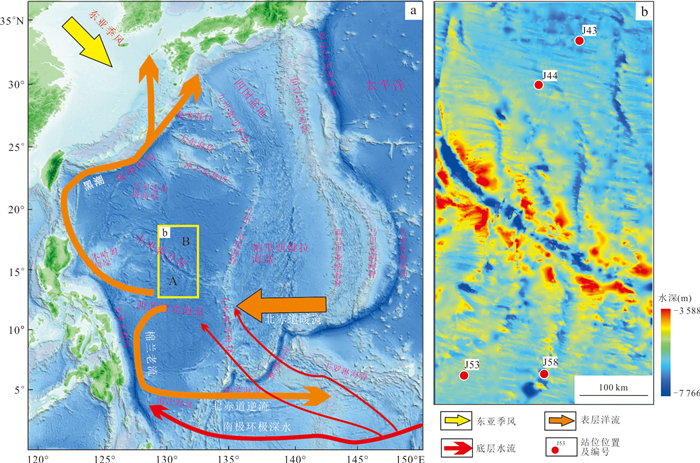
 下载:
下载:
